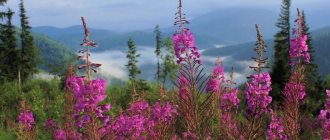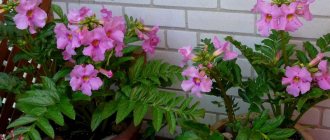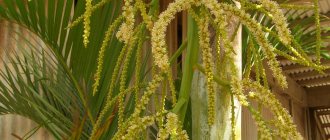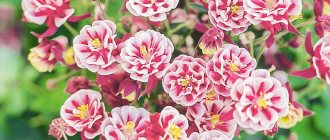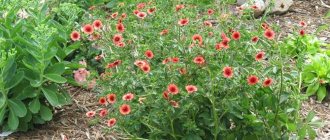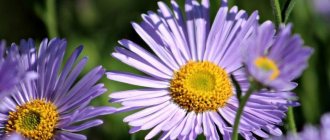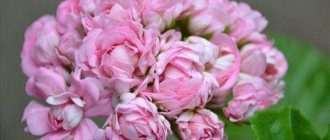A flowering plant such as hydrangea (Hydrangea) is directly related to the hydrangea family. According to various sources, this genus includes 30–80 species of hydrangeas. Such plants are represented by compact trees, vines and shrubs. Most types of hydrangeas grow in South and East Asia (China, Japan); this plant can also be found in North America and the Far East. This plant was named after the princess of the Holy Roman Empire. Taxonomists gave the plant the Latin name Hydrangea, which means “vessel of water.” The fact is that it is characterized by great moisture-loving properties. In Japan, this plant is called "ajisai", which means "purple sun flower". Despite the large number of species, only garden hydrangea or large-leaved hydrangea, which is small in size, is grown at home. Other species and varieties are grown exclusively in gardens.
Brief description of cultivation
- Landing. In the fall, sow seeds for seedlings, followed by planting seedlings in open ground in early spring two years later. In the south, seedlings can be planted in the ground in the fall.
- Bloom. From early summer to late autumn.
- Lighting. Partial shade in the southern area, bright sunlight in the middle zone and more northern regions.
- The soil. Rich and moist, free of lime (pH 5.0).
- Watering. Weekly and abundant, water consumption is 15 - 20 liters per plant.
- Feeding. At the beginning of spring - with a urea solution, after flowering - with complex mineral fertilizer.
- Trimming. Every year from 3-4 years. Paniculata and tree-like - in March-April.
- Reproduction. By seeds, dividing the bush, grafting, layering and green cuttings.
- Pests. Spider mites.
- Diseases. Downy mildew, chlorosis.
Hydrangea: care, planting, pruning
Features of hydrangea
In the wild, hydrangea is represented by three-meter shrubs, not very large trees, as well as vines that can climb tree trunks to a height of thirty meters. Also, such hydrangeas can be deciduous or evergreen (depending on the type). In mid-latitudes, deciduous species are most preferred to grow. Most often, such a plant has oppositely arranged leaves of large size; they are oval in shape with a point at the top. The edge of the leaf blades is most often jagged, and veining is clearly visible on their surface. Hydrangea begins to bloom in the spring, and ends only after the onset of frost in the fall. The flowers are collected in large inflorescences, which can have a corymbose, spherical or paniculate shape. The inflorescences include 2 types of flowers. Some of them are small fertile (fertile), located, as a rule, in the middle part of the inflorescence, while others are large sterile (sterile), which are located along the edge of the inflorescence. There are species that have only one fertile flower. Most hydrangeas have white flowers. However, there are species, for example, large-leaved or large-leaved hydrangea, which can have flowers of various colors: cream, white, blue, pink, red and lilac. It is interesting that the exact color of the flower is influenced by the pH value of the soil. So, for example, if the substrate is neutral, then the flowers will be cream or beige, if alkaline, then pink or lilac, and if the substrate is acidic, blue, because the soil contains aluminum, which is easily absorbed by hydrangea. The fruit of this flower is a capsule with 2–5 chambers, which contains small seeds. It happens that a flower belonging to the close genus Schizophragma is mistakenly called hydrangea, but you should know that petiolate hydrangea is nothing more than a schizophragma.
Growing hydrangea
How to properly grow hydrangea in the garden? Here are the basic rules:
- Large-leaved hydrangea can have different flower colors. Moreover, their color depends not on the variety, but on the pH of the soil. So, in acidic soil the flowers are blue and blue, in neutral soil they are white and beige, and in alkaline soil they are lilac or pink. In order for the bush to be spectacular and colorful, experienced gardeners advise changing the acidity separately for each flower.
- This flower loves moisture very much; therefore, it must be watered not only abundantly, but also on time.
- Direct sunlight is required. But it is worth considering that flowers can fade under the influence of the scorching rays of the midday sun. In this regard, you need to choose a place for planting where there is slight shading at noon.
- Also, the plant must be pruned on time.
- You cannot apply a lot of organic fertilizers, because flowers may not appear on overgrown bushes.
- Hydrangea must be well covered for wintering, even those species that are considered frost-resistant. If one of the bushes freezes, then in most cases it will be able to fully recover during a period of intensive growth.
- Very resistant to diseases and pests.
How to grow a gorgeous hydrangea? Proper planting and care. Paniculate and large-leaved.
Diseases and pests
Hydrangea itself has excellent immunity and is rarely susceptible to disease. But there are several diseases and pests that can cause serious damage.
- Chlorosis. Occurs as a result of excess moisture, humus or lime. It is treated by irrigation with copper sulfate and potassium nitrate.
- Due to too humid air, a problem such as powdery mildew . The fight against the disease is carried out using irrigation with a solution of laundry soap and vitriol (copper or iron).
- Green leaf aphid. Garlic infusion is used: 200 g of garlic (finely chopped), 40 g of household soap and 20 liters of water. The bush should be sprayed until the pests disappear completely, usually every day for a week.
Planting hydrangea
Growing from seeds
As a rule, it is very easy to propagate species of hydrangeas by seeds. Also, this method of reproduction is often used by breeders in their work. Growing such a flower from a seed is quite easy, but it is a time-consuming method. Seeds need to be sown in autumn. To do this, you need to fill the container with a loose soil mixture rich in nutrients, which can be prepared by combining peat and leaf soil with river sand in a ratio of 2:4:1. Seeds sown on the surface of the substrate should be sprinkled with a thin layer of soil and then watered with a spray bottle. Then the container must be covered on top with a transparent film or glass, and the cover must be removed several times to ventilate the soil. It should also be taken into account that the soil should be slightly moist all the time. The optimal temperature is from 14 to 20 degrees. After the first seedlings appear, the shelter must be removed for good. Picking must be done 2 times. The first time is at the stage of development of the cotyledon lobes, and the second time is in the first month of spring. At the same time, diving the plants a second time, you need to take small pots (diameter 7 centimeters) for each of them. After you transplant the young plants for the second time, you need to start hardening them off. To do this, flowers are taken outside in the summer and a place is chosen for them that is protected from direct rays of the sun, gusts of wind, drafts and precipitation. In the evening, hydrangeas are returned indoors. For 2 years, hydrangea must be grown indoors, and in winter it is kept in a fairly cool and well-lit room, and in summer it is moved outside. In this case, it is necessary to tear off all the buds, as they will take a lot of strength from the still young plant.
How to sow hydrangea seeds? Features of cultivation!
Hydrangea seedlings
After 2 years, at the very beginning of the spring period (in areas with a cold climate - in the autumn), the grown flowers are transplanted into open soil, immediately to a permanent place. When choosing a suitable place, do not forget that all species are photophilous and need direct rays of the sun. However, there are several species (ground cover, Sargent, rough and tree) that thrive in partial shade. The soil should be loose, enriched with organic matter, neutral or slightly acidic. Alkaline soil can be acidified by using high-moor peat or Acid Plus acidifier. It is not recommended to plant trees or shrubs that have a superficial root system next to these flowers, since after some time these plants will fight with each other for water and nutrients.
The first step is to dig a hole, and its size should be 2 times the volume of the root system of the seedling along with the pulled out lump of earth. Then organic and mineral fertilizers, as well as peat, must be added to the hole, which should be mixed with the soil. Then the seedling taken out along with a lump of earth must be thoroughly shaken off the soil and the roots leveled. It is then lowered into a hole, which is covered with a mixture of compost and soil. In this case, it is necessary that the root system rises very slightly above the soil surface. Then the soil should be compacted, the bush should be watered and the area should be covered with mulch (bark or pine needles).
A proven method for planting hydrangeas / Garden Guide
Caring for hydrangea in open ground
Basic rules of care
Caring for such a plant grown in open ground is not difficult, but it must be done correctly. Proper watering is of great importance for the normal development of hydrangea. So, in hot weather it needs to be watered 2 times every 7 days, while 3–5 ten-liter buckets of lukewarm and definitely settled water should be poured onto 1 adult bush. In the case where there is mulch in the form of peat on the site, watering can be reduced.
In order for more oxygen to reach the roots, you need to loosen the surface of the soil around the plant several times a season to a depth of about 5 centimeters. You also need to promptly cut off those stems that have already faded.
Hydrangea fertilizer
In order to achieve the most abundant flowering, you need to feed such a flower at least 2 times a year. This must be done before the plant begins to bloom and after it has faded. At the very beginning of spring, a urea solution (2 g per 1 liter of water) is used to feed hydrangeas. In this case, 1 bush will require 30 liters of this solution. When the plant fades, complex mineral fertilizer should be used to feed it. During the summer, experts advise using slurry as a top dressing. However, do not overdo it, because overfed hydrangea has very large inflorescences that can break rather fragile branches. To avoid this, you can tie up the bush.
Mineral fertilizers for hydrangea / Garden guide
Pruning hydrangea
Bushes that are older than 3–4 years should be pruned. Species blooming on the stems of the current year should be pruned at the very beginning of the spring period, before the buds begin to open, and also before the sap begins to flow, otherwise the plant may bleed sap, which will lead to its death. However, after pruning done very early, cuttings cannot be rooted. In this regard, pruning should be carried out at a time when the buds begin to look alive and swell a little. Tree hydrangea is the first to awaken, so it needs to be pruned first. Its very long stems are cut off at a height of 3–4 buds. After this, the resulting branch can be divided into cuttings. Paniculate hydrangea requires more careful pruning. So, last year’s stems need to be shortened by 1/3, but viable cuttings are obtained from such segments. Large-leaved hydrangea does not need to be heavily pruned. So, in spring, only every 4th stem is pruned, especially if it grows inside the bush. It is also necessary to remove dried and damaged branches.
Propagation of hydrangea by cuttings
After pruning the hydrangea, you will have a large number of stem sections, and you can make cuttings from them. Each cutting should have 2 nodes. In this case, the cut above the node located at the top should be straight, and under the one at the bottom - oblique. In this case, you should retreat 2-3 centimeters from the knot, and then make a cut. Fill the greenhouse container with a mixture of peat and sand and stick the cutting to a depth of 3 centimeters, while watering it thoroughly. After this, the top of the greenhouse should be covered with a plastic film “house”. The cuttings need to be systematically moistened with a spray bottle so that the soil is always slightly moist. After complete rooting, the cuttings should be planted in open soil in a permanent place. They should have time to get stronger before winter.
Propagation of hydrangea by cuttings

